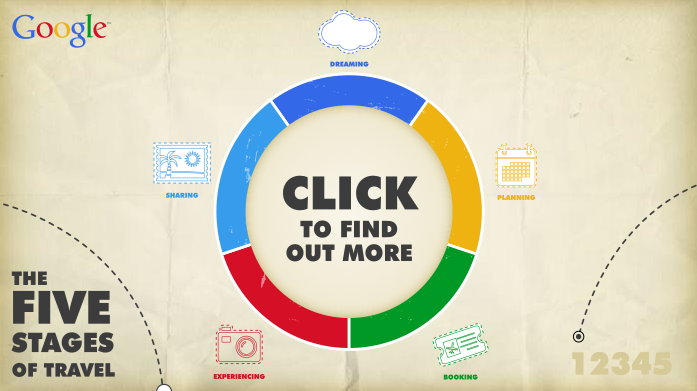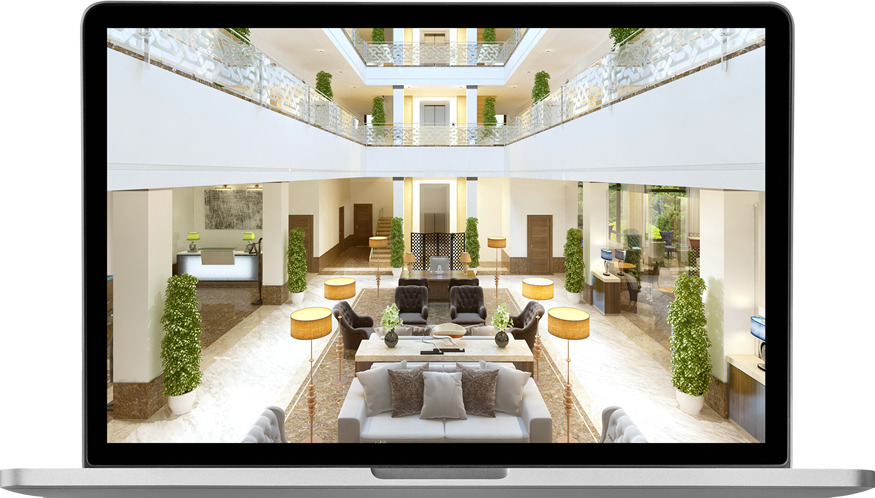If you were to ask most travelers how many distinct stages are involved in the general act of traveling, I would guess that most people would identify two: the research phase and the booking phase. And for most people that’s what they do–they research the destination, the transportation, the rates, and then make a final decision that leads to the booking for hotel rooms, flights, and car rentals.
It’s a good start, and I’m guessing that many hoteliers are only concerned with the actions a potential guest takes up to the point where they actually select their hotel, but it’s not the whole picture.
In fact, Google has identified 5 stages of travel, and as online marketers, it’s important for us to target customers at each point in that buying process.
Research and Booking: A Fraction of the Travel Cycle
For most hotels, the booking is the final goal of their online marketing efforts. It is seen as a linear path that starts off with the consumer planning and researching their travel plans online and finishing at the checkered flag at the hotel reservation.
Unfortunately, once that guest crosses the finish line some hotels will wipe their hands clean of that customer. Well, you could stop there…but then you’d be missing out on a huge opportunity to foster brand loyalty and have guests’ experiences at your hotel work in your favor long after their stay in the form of word-of-mouth advertising.
Google’s Take On How We Travel
Just take a look below at this nifty little infographic that Google developed, identifying what they consider the 5 Stages of Travel. Whether you agree or disagree with the specific stages featured below, there’s no denying that there is a multi-faceted sales cycle and different online marketing tactics can and should be used to target travelers at each of the various phases in this process.
Whether the customer is dreaming about their next vacation or experiencing it firsthand, it provides a huge opportunity to connect with your customers at each of these key moments in their travel buying cycle.

So based on this interactive infographic from our buddies at Google, how can hotels target potential customers as they move from stage to stage in planning their vacation?
Stage 1: DREAM A Little Dream
As a traveler, you’ve got to start with a dream. Maybe you saw a billboard of a spectacular Hawaiian sunset emblazoned with the simple phrase, “Visit Hawaii.” Maybe your friend just posted a video of their hilarious attempt at surfing in Maui on Facebook.
Or maybe your little nephew just picked up the ukulele and suddenly your mind wanders to the land of luaus, leis, and lava rock. And then again, maybe it’s 3 degrees in Chicago and you just need one sweet week of pure tropical escape.
Regardless of how the idea entered your head, you’re now starting to talk it over with your friends and family, casually tossing out the idea of heading to the Aloha state in the next year. The seed has been planted…and it won’t take long for that palm tree to grow.
Why is this stage important?
- In 2011, 49% of leisure travelers reported researching online after viewing an online ad. Start that spark early and get potential guests moving through these 5 stages of travel. The dream is what starts the potential customer through the buying cycle.
So how does a hotel reach this dreamer in stage 1?
- Email marketing: Reach out to your past guests with a well-timed email campaign. Hopefully, you’ve made good use of your email collection form on your website or have been diligently collecting emails at your front desk and now have a solid list of interested travelers just waiting for that perfect vacation idea. Put an idea in their head.
- Social media: Encourage past guests to share their experiences on your social media channels. The end of their trip can be the spark that ignites the start of a future traveler’s trip. Expand your word-of-mouth reach by encouraging your guests to share and interact with your communities online.
The social media component should be present at all stages and helps to tie the hotel to the user throughout the process. However, it’s more critical as a word-of-mouth marketing opportunity when people start dreaming about and researching their potential trip.
- Blog about it: After a while websites for big brand hotels can get a little stale. There’s only so much new content than can be run through the limited pages within the official brand site. Standalone websites allow for a little more flexibility but can still run into the same problem.
Creating a blog allows you to open the floodgates of possibilities for new and exciting content. With a blog, you are not bound by the confines of an accommodations page, a dining page, a services page and so on.
Blog about top things to do in your city; write about the amazing new restaurant that just opened up near your hotel; or, inform readers of the Star Wars convention that’s coming to town and what to do if you encounter a Jawa.
The blog allows you to generate plenty of new content on a regular basis, and best of all, search engines crawl this new content quickly, giving you plenty of opportunities to rank for new niche keywords.
Stage 2: PLANNING The Master Plan
Now you’ve got them thinking. That random consumer is now a potential traveler because you’ve managed to spark an interest in a future trip. But you still have a long way to go before you’re rolling out the red carpet for Anonymous Hotel Guest #1.
Your hotel is just one of many in a nebulous idea-cloud of potential destinations and locations. In fact, over the course of this consumer’s travel cycle, he or she will have visited over 20 different travel websites in over 9 separate research sessions on the internet.
Yep, you’ve got some competition. The question is: how do you help the consumer cut through the online clutter to see that ethereal beam of light illuminating only your hotel?
Why is this stage important?
- The average traveler visits over 20 different travel websites before making a booking
- 62% of leisure travelers use the internet for researching their trip
So how does a hotel reach this planner in stage 2?
- Diversify: Did you read that? Consumers research at least 20 different travel websites! Yikes! This means that travelers are going to be checking all kinds of channels to compile their research about their vacation: TripAdvisor, OTAs, hotel websites, Google searches, blogs, social media channels and more. It’s true that you probably can’t be everywhere online at once (particularly with a modest budget), but the key is to create enough of a presence on these sites to at least have a fighting chance. Just be careful not to spread yourself too thin!
- Search engine optimize your website: Hopefully you didn’t wait until now to realize that your website should be optimized. Stage 2 and 3 are where your SEO efforts should start to pay off. Make sure you’ve conducted thorough keyword research to determine what your customers are searching for.
Did you optimize the content on your official hotel website? What about any independent websites you own?
- Optimize your local listings: Nothing helps a traveler orient themselves like local mapping sites such as Google Maps or Bing Maps. Make sure your hotel’s listing in the local search results is claimed and fully optimized so travelers can find you as they investigate their potential destinations.
- Clean up your OTA listings: I know. You don’t like the OTAs. They don’t always rank your hotel first in your city and they eat away at your rates with their ever-growing commissions. Still, if you opt out of OTAs or don’t optimize your listings, you’re missing out at likely one of the first opportunities your hotel will have at getting in front of the customer.
Let’s face it, whether you like it or not, people love to comparison shop. Hotels are no exception to this online shopping trend. And sites like Expedia make it so dang easy to compare you and all your competitors it should be criminal! …if it wasn’t so helpful for the consumer. And when it comes down to it the OTAs aren’t all bad for hotels. You may have to play the game, but you don’t have to like it.
- Manage your online reputation: Sign up for Google Alerts to monitor online buzz about your hotel, respond to TripAdvisor reviews (good and bad), address comments on your social media channels and just be aware of what users are saying about your hotel online in general.
If you don’t speak up for your property then the public will have the final say in your reputation. If you don’t communicate you let the most vocal consumers determine your fate. Don’t sit on the sidelines.
Stage 3: No Reservations About Making A BOOKING
By now the research stage is just about over and Johnny McHotelguest is ready to lay down some clams for what he hopes will be a vacation that lives up to his dreams from stage 1. How easy is it for this consumer to find your website now that he knows he wants to book?
Will he find you though your official brand website? An OTA? Groupon? Ideally, you’d like him to book through your official brand site, but what have you done to ensure that your site is found first.
Why is this stage important?
- 37% of travelers said the internet was the primary source prompting them to book (word-of-mouth was the second most important factor to influence bookings, coming in at 16%)
So how does a hotel reach this booker in stage 3?
- Don’t make people think: Make your website easy navigate and easy for users to reach their goal. Usability is crucial to getting users on your site to convert to booking guests.
If you make the booking process too cumbersome or make it difficult for users to navigate your site, potential guests will look elsewhere to book their vacation.
Include a reservation widget on every page of your site; don’t call the link in your main navigation bar “Your Special Day” instead of “Weddings;” and don’t clutter pages with unnecessary bells and whistles that overshadow the main site content. Precious seconds lost to these usability disasters can mean the difference between a booking guest and just another free-loadin’ website visitor.
- Optimize for your brand – In the previous stage, users were researching their travel plans and were likely searching for more generic keywords such as “downtown Chicago hotels” instead of “Hilton Chicago.”
Now that they have narrowed down their search and are ready to book, make darn sure that your site appears for its brand keywords. It seems like a simple thing that should be common sense, and most websites should already be ranking well for their brand terms, but this is key and isn’t always guaranteed to be the case by default. Some smaller brands may need to work to optimize for their brand name. Also, travelers may not know your domain name, so they’ll likely run a search using some variation of your brand name. Make sure that your site appears in natural, local and PPC search for brand-related terms.
They’re in the home stretch of the buying funnel and it would be awful to work so hard to drive qualified website traffic, only to lose the customer right before they cross the finish line.
Stage 4: It’s About The EXPERIENCE
At this point you’ve got the customer right where you want them…at your hotel! While online marketing can still help to some degree, for the most part, it is up to the hotel staff to create a memorable experience for the guest on site.
Do you provide good service? Is your property remarkable in any way? Have you exceeded the customer’s expectations? The greatest impact to a guest’s experience happens on property and will influence their decision to return to your hotel in the future and share their experience with friends in Stage 5.
Why is this stage important?
- 53% of travelers have used a mobile device to find travel-related information
So how does a hotel impact a traveler’s experiences in stage 4?
- Presentation is everything – You’re only as good as the product you’re selling. If your hotel is dated, dilapidated and disgusting then no amount of friendly, attentive customer service is going to win your guest over. Take care of your product.
- Service with a smile – Make sure that the friendly, accommodating attitude conveyed through your website and social media channels is reflected in the service the customer receives at the actual hotel. Keep a consistent voice online and offline.
- Tie offline marketing with online marketing – Speaking of keeping consistency from the last point, make sure that you are promoting your social media channels in the offline world at your property as well.
Whether it’s Facebook and Twitter decals at your front desk, readerboards that flash “Like our Facebook Page,” or Foursquare check-ins at your restaurant, you have people at your hotel that like your product enough to give you money. Why not remind them to participate in your social media communities as well?
Stage 5: SHARING The Moments
This is the point at which the traveler who just experienced their dream vacation can help plant the seeds for someone else to start their journey down the 5 stages of travel. Whether it’s a well-written user review, a great photo of the hotel’s pool deck, or a quick tweet about all the great restaurants right next to the hotel, harnessing this word-of-mouth marketing is the key to a successful social media marketing campaign, and perpetuating the 5 stages of travel for others.
Why is this stage important?
- 53% of leisure travelers say they share pictures of their vacations online
- 49% of leisure travelers enjoy reading about others’ online experiences, reviews, opinions and general travel information
So how does a hotel encourage travelers to share their experiences in stage 5?
- Tell them where to share: Similar to the final bullet in the previous stage, let guests know where they can share their experiences. Hotels should have Facebook, Twitter, Foursquare, TripAdvisor and other icons present at the front desk, to alert guests that they can engage with your property and share their opinions through those participating channels. Make it even easier for guests by providing a friendly URL or a QR code that takes guests directly to those sites. You may even want to have a card in the room near the high-speed internet instructions that mentions your presence on these social media channels.
- All you have to do is ask: Front desk agents should encourage satisfied guests to share their opinions on the various channels mentioned above. While bribing or forcing the customer to leave good reviews is against many sites’ terms of service–not to mention a generally bad approach–it doesn’t hurt to remind guests to share positive experiences with others.
- Reward creative user-generated content: Host a contest at your hotel that seeks to reward the guest who posts the funniest/wackiest/most entertaining photos/story/experience about the hotel or the city on a social media channel of your choice.
This not only gets guests to interact with your brand, but it also encourages them to spread the word about the contest and consequently your hotel. Better prizes can lead to better reach, but sometimes just the satisfaction of winning the competition can go a long way towards spreading the love.
- Collect contact info: Be sure to collect info from customers who may be interested in dreaming about traveling to your hotel in the future. Have front desk agents ask for their email address or Twitter handle so that you can plant the seeds of travel in their head and start the cycle all over again.
What does this all mean?
The typical vacation planning and travel buying cycles are pretty complex. At its most basic, a typical traveler’s path to vacationland can be broken down into 5 stages.
Targeting hotel guests at these 5 stages of travel helps increase reservations. (Tweet This)
Many people often think of online marketing as simply selecting the right keywords and optimizing a website for those keywords in Google. That is only a small piece of the pie. And you can never have a truly effective online marketing campaign by only focusing on a single channel at a single point in a traveler’s buying cycle.
To neglect to target the user at the other stages of their buying process is to miss out on a huge opportunity to digitally greet them at every step of the way to their purchase.
In the end, properly targeting potential guests at each of these 5 stages is crucial to ensuring that they not only book at your hotel, but perpetuate that buying cycle for the next vacationer too! Ah, the circle of life….
When you need assistance in targeting your future guests in these stages of travel, don’t hesitate to reach out to Blue Magnet Interactive. We’d love to discuss how we can help your hotel drive more bookings.




